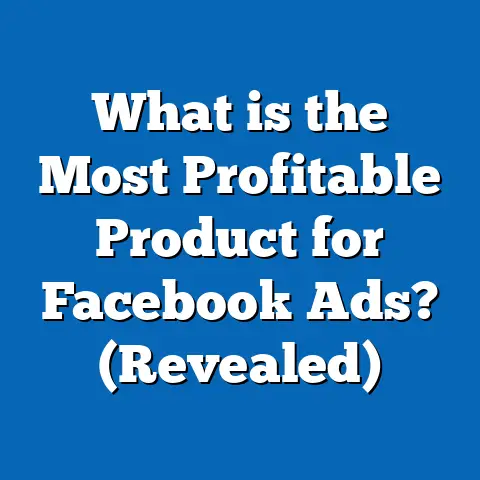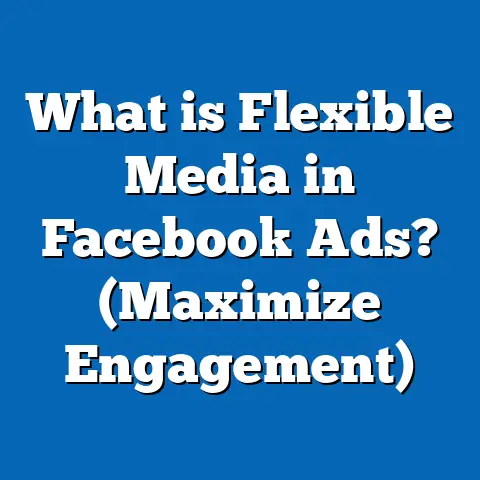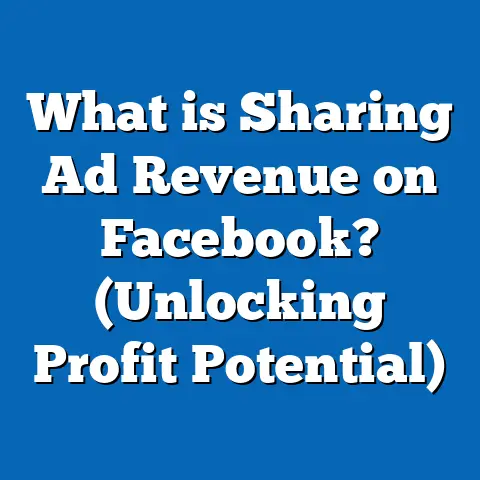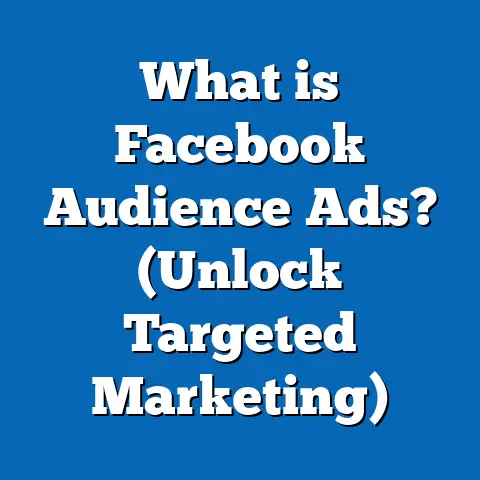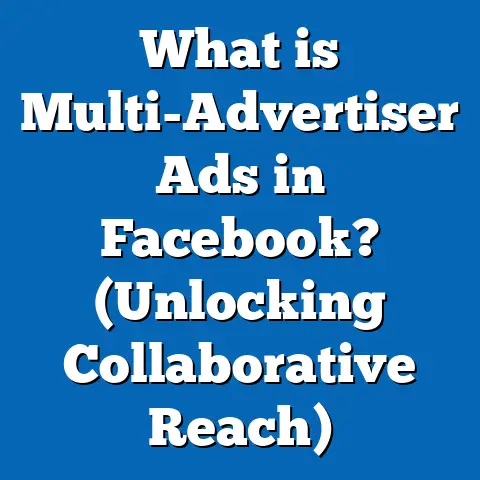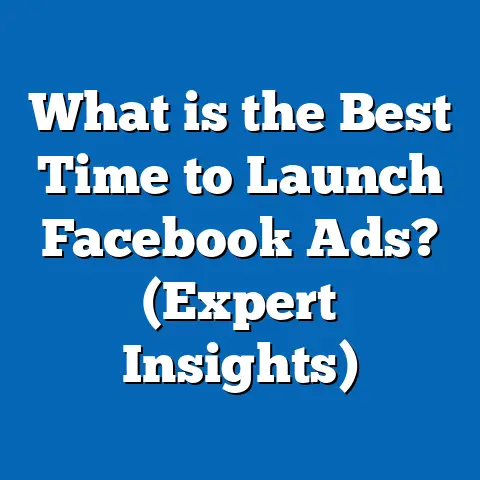What is the Best Objective for Facebook Ads? (Maximize ROI)
What is the Best Objective for Facebook Ads? (Maximize ROI)
Imagine scrolling through your Facebook feed. You see an ad—a vibrant image paired with a compelling message that instantly grabs your attention. The product or service feels like it’s made just for you. You click, explore the website, maybe even make a purchase. This seemingly simple moment is the outcome of a complex process built on choosing the right Facebook ad objective, targeting, and optimization strategy.
For marketers and business owners, understanding how to select the best Facebook ad objective is crucial to maximize return on investment (ROI). Facebook’s ad platform offers a variety of objectives, each designed to achieve specific goals within the customer journey—from awareness to conversion. However, with so many options available, picking the wrong objective can lead to wasted budget and missed opportunities.
Understanding Facebook Ad Objectives: The Foundation of Success
What Are Facebook Ad Objectives?
Facebook ad objectives are predefined goals that you select when creating a campaign. They instruct Facebook’s delivery system on what actions you want users to take after seeing your ads. Whether you want to build brand awareness, drive traffic to your website, generate leads, or increase sales, Facebook has an objective tailored for that purpose.
Objectives are grouped into three broad categories:
- Awareness: Designed to generate interest in your product or service.
- Consideration: Encourage people to think about your business and seek more information.
- Conversion: Aim to drive valuable actions such as purchases, sign-ups, or visits.
The objective you choose directly influences how Facebook targets your ads and optimizes delivery. For example, if you choose a conversion objective, Facebook will show your ads to users most likely to take that action based on past behavior.
Why Choosing the Right Objective Matters for ROI
Return on Investment (ROI) is the key metric businesses care about when spending money on advertising. ROI measures how much profit you make relative to your ad spend. Without a clear objective aligned with your business goals, your ad campaigns risk low engagement, poor conversion rates, and ultimately wasted budget.
According to WordStream’s 2023 report on Facebook Ads:
- Campaigns with clearly defined objectives achieved 30% higher conversion rates.
- Advertisers saw a 25% lower cost per acquisition (CPA).
- Businesses optimizing for conversions rather than clicks saved an average of 20-35% on costs.
These numbers highlight that clarity in campaign objectives is not just a technical detail—it’s a strategic necessity.
Detailed Breakdown of Facebook Ad Objectives
Facebook offers multiple objectives across its three categories. Each serves different purposes and suits different stages of the marketing funnel. Let’s examine these in detail.
Awareness Objectives
Brand Awareness
Goal: Increase overall awareness of your brand among potential customers.
When you want people to recognize your brand name or product but aren’t focused on immediate sales or actions, the Brand Awareness objective is ideal. Facebook uses an algorithm optimized for ad recall, showing your ad to users more likely to remember it.
Best Use Cases:
- New product launches.
- Companies entering new markets.
- Building recognition in competitive industries.
Pros:
- Maximizes reach among targeted audiences.
- Helps build long-term brand equity.
- Often lower cost per impression (CPM).
Cons:
- Difficult to directly measure ROI.
- Low immediate sales impact.
Data Insight:
Facebook’s internal study found that brand awareness campaigns increased ad recall by 60%, but direct sales uplift was only about 5-7%. This means brand awareness lays groundwork for future conversions but isn’t a quick sales driver.
Reach
Goal: Show your ads to as many people as possible within your target audience.
Reach campaigns prioritize delivering impressions over engagement or conversions. They’re useful for one-time promotions or events where maximum eyeballs are needed fast.
Best Use Cases:
- Flash sales.
- Event announcements.
- Public service messages.
Pros:
- Maximum exposure.
- Useful for time-sensitive offers.
Cons:
- Can lead to ad fatigue quickly.
- Low-quality engagement.
Facebook reports that reach campaigns typically cost less per 1,000 impressions but have lower click-through rates (CTR) compared to other objectives.
Consideration Objectives
Consideration objectives focus on nurturing interest and encouraging users to engage with your brand or learn more.
Traffic
Goal: Drive traffic to your website, landing page, or app.
This objective is popular among businesses wanting to increase site visits. It’s useful when the goal is to expose users to product details, blog content, or app downloads.
Best Use Cases:
- E-commerce sites promoting new products.
- Content marketing campaigns.
- App installs or visits.
Pros:
- Increases website visits and potential leads.
- Allows retargeting site visitors later.
Cons:
- Website visits don’t guarantee conversions.
- Costly if targeting isn’t optimized.
Data Insight:
AdEspresso’s 2023 benchmark data shows average CPC (cost per click) ranges between $0.40 – $1.50 depending on industry verticals—higher in competitive sectors like finance or legal services.
Engagement
Goal: Boost interactions such as likes, comments, shares, or event responses on your posts.
Engagement campaigns help build community and social proof around your brand. They are particularly useful for pages looking to increase organic reach and audience interaction.
Best Use Cases:
- Promoting contests or giveaways.
- Increasing post visibility.
- Enhancing social proof for new products.
Pros:
- Helps increase organic reach via interactions.
- Builds trust by showing active audience participation.
Cons:
- Engagement does not always translate into sales.
- Can attract low-value or irrelevant interactions.
Video Views
Goal: Get as many people as possible to watch your video content.
Video ads are powerful storytelling tools. The Video Views objective optimizes delivery toward users who watch videos longer or more frequently.
Best Use Cases:
- Product demonstrations.
- Brand storytelling.
- Tutorials and testimonials.
Pros:
- High engagement rates.
- Builds emotional connection with viewers.
Cons:
- Viewers may not always take further action after watching.
- Requires investment in quality video production.
Lead Generation
Goal: Collect leads directly within Facebook via forms without requiring users to leave the platform.
Lead Gen campaigns simplify the lead capture process by pre-filling forms with user data from their profiles. This is especially effective for B2B companies and service providers requiring contact information for follow-up.
Best Use Cases:
- Software demos.
- Event registrations.
- Newsletter signups.
Pros:
- Low friction for users submitting their information.
- Integration with CRM for streamlined follow-up.
Cons:
- Lead quality varies by targeting and form design.
- Follow-up strategy critical for converting leads into customers.
Conversion Objectives
Conversion objectives focus on driving valuable business actions—whether purchases, sign-ups, or app installs—with measurable ROI impact.
Conversions
Goal: Drive specific actions on your website or app such as purchases, sign-ups, or downloads tracked via Facebook Pixel or SDK.
This is the most powerful objective for businesses focused on direct sales or measurable results. Facebook optimizes delivery towards users most likely to complete these actions based on historical data.
Best Use Cases:
- E-commerce stores aiming for sales.
- Subscription services seeking sign-ups.
- Apps targeting installs.
Pros:
- Optimizes for actual business outcomes.
- Supports detailed pixel tracking and retargeting strategies.
Cons:
- Requires proper pixel setup and event tracking.
- Algorithm needs learning phase before peak performance.
Catalog Sales
Goal: Promote products dynamically from your catalog based on user behavior and preferences using Facebook’s Dynamic Ads feature.
Catalog Sales campaigns are ideal for retailers with large inventories who want personalized product recommendations at scale.
Best Use Cases:
- Online retail stores.
- Businesses with frequently changing inventory.
Pros:
- Automated ad creation for thousands of products.
- Personalized targeting boosts relevance and conversions.
Cons:
- Requires complex catalog setup and syncing.
- Inventory management must be up-to-date continuously.
Store Traffic
Goal: Drive offline visits to physical store locations by targeting local customers nearby.
Store Traffic campaigns help brick-and-mortar businesses measure foot traffic influenced by online ads using location data and offline sales tracking.
Best Use Cases:
- Retail shops promoting in-store sales.
- Restaurants advertising local offers.
- Service providers targeting nearby customers.
Pros:
- Bridges online advertising with offline purchases.
Cons:
- Limited reach geographically.
- Offline conversion tracking can be challenging without integration tools.
How to Choose the Best Objective for Your Business
Selecting the right objective requires aligning your business goals with customer behavior and your marketing funnel stage. Here’s a step-by-step approach:
Step 1: Clarify Your Primary Business Goal
Start with clear answers:
- Are you trying to increase brand awareness?
- Do you want more traffic or leads?
- Is your focus on driving direct sales?
Your priority will determine whether you choose an Awareness, Consideration, or Conversion objective.
Step 2: Understand Your Customer Funnel Stage
Map your target audience based on where they are in their buying journey:
| Funnel Stage | Suitable Facebook Objective(s) |
|---|---|
| Top (Awareness) | Brand Awareness, Reach |
| Middle (Interest) | Traffic, Engagement, Video Views |
| Bottom (Decision) | Conversions, Catalog Sales, Store Traffic |
This ensures you’re speaking the right language at each stage—building interest first before pushing for action.
Step 3: Evaluate Your Tracking Infrastructure
Conversion-focused objectives require robust tracking:
- Install Facebook Pixel on your website.
- Define custom conversion events (e.g., Add To Cart, Purchase).
- Use SDKs for app tracking if applicable.
Without this setup, Facebook cannot optimize effectively for conversions, reducing campaign performance significantly.
Step 4: Set Realistic Budgets and Expectations
Conversion campaigns often need a learning phase where Facebook tests different audiences and optimizations. Budget accordingly:
- Allocate at least $20-$50 daily during learning phase.
- Avoid major changes until learning completes (~50 conversions).
Step 5: Test Different Objectives & Measure Performance
Run split tests comparing two or more objectives:
Key metrics:
| Metric | What It Tells You |
|---|---|
| CPA (Cost per Action) | Efficiency of driving desired action |
| ROAS (Return on Ad Spend) | Profitability of campaigns |
| CTR (Click-through Rate) | Engagement level of ads |
| Frequency | Risk of ad fatigue |
Use this data to double down on winning objectives and optimize budgets accordingly.
Real World Examples & Case Studies
Let’s explore some detailed case studies demonstrating successful use of specific objectives:
Case Study 1: E-Commerce Brand Increasing Sales with Conversion Objective
A mid-sized fashion retailer initially ran Traffic campaigns directing users to product pages but faced high bounce rates and poor sales conversion. After installing Facebook Pixel and switching to Conversion objective optimized for purchases:
Results after 3 months:
- CPA dropped from $25 to $15.
- ROAS improved from 2x to 4x.
Key factors:
- Pixel enabled better targeting of high-intent users.
- Retargeting abandoned carts improved completion rates by 20%.
Case Study 2: SaaS Company Using Lead Generation Objective
A SaaS provider targeting small business owners ran Lead Generation ads offering free demos:
Outcomes in one month:
- Collected 1,200 leads at $8 CPL (cost per lead).
- Lead quality improved due to refined audience segmentation.
Actionable insight:
A follow-up email sequence increased demo bookings by 35%, turning leads into paying customers efficiently.
Case Study 3: Local Restaurant Driving Foot Traffic Using Store Traffic Objective
A restaurant used geo-targeted Store Traffic campaigns promoting lunchtime specials:
Result over two months:
- Foot traffic increased by 18%.
- Offline sales uplift tracked via POS integration showed 12% increase linked to ads.
Lessons learned:
Combining online promotions with location-based targeting yielded measurable offline results—a key win for local businesses adapting digital marketing tactics.
How Facebook Ads Compare With Other Platforms’ Objectives
Understanding Facebook’s unique strengths helps put its objectives in context with other platforms:
| Platform | Objective Categories | Unique Strength |
|---|---|---|
| Awareness, Consideration, Conversion | Deep behavioral targeting; vast user data | |
| Google Ads | Sales, Leads, Traffic | Search intent targeting; high intent audiences |
| LinkedIn Ads | Lead Gen Forms, Website Visits | B2B professional audience focus |
| TikTok Ads | Awareness, Traffic, Conversions | Younger demographics; viral content potential |
For businesses looking for detailed audience targeting across demographics and interests combined with versatile objectives, Facebook remains unmatched. However, complementary channels like Google Search excel at capturing user intent closer to purchase decisions.
Advanced Strategies To Maximize ROI Using Facebook Ad Objectives
Here are some proven strategies marketers use:
1. Campaign Budget Optimization (CBO)
CBO allows Facebook to automatically distribute budget across ad sets based on real-time performance toward your objective. This maximizes efficiency without manual budget shifts.
2. Lookalike Audiences
Create audiences similar to your best customers using Lookalike Audiences. This improves conversion rates as ads target users most likely interested in your offerings based on behavior patterns.
3. Retarget Warm Audiences With Conversion Campaigns
Retargeting users who engaged but didn’t convert using Conversion objectives often yields high ROI since these users already show interest.
4. Creative Testing Aligned With Objectives
Match creative style with objective:
| Objective | Creative Tips |
|---|---|
| Brand Awareness | Emotional storytelling; brand logos |
| Traffic | Clear CTAs; product images |
| Engagement | Interactive posts; questions |
| Video Views | Short engaging videos |
| Lead Generation | Benefits-focused messaging |
| Conversion | Social proof; urgency; clear purchase path |
Test multiple formats (carousel vs single image vs video) regularly to optimize engagement and conversions per objective type.
5. Monitor Frequency & Refresh Creatives Regularly
High frequency causes ad fatigue lowering ROI. For conversion campaigns especially:
- Refresh creatives every 1–2 weeks.
- Rotate offers or messaging variants frequently.
6. Leverage Offline Conversion Tracking
For Store Traffic or local business campaigns integrating offline sales data closes the attribution loop improving optimization accuracy and budget allocation decisions.
Metrics That Matter For Each Objective
Tracking the right KPIs ensures you’re measuring success accurately:
| Objective | Key Metrics | Best Practices |
|---|---|---|
| Brand Awareness | Ad Recall Lift, Reach | Survey-based measurement; impression frequency control |
| Traffic | CTR, CPC | Optimize landing pages; reduce bounce rate |
| Engagement | Likes, Shares, Comments | Focus on meaningful interactions |
| Video Views | View Rate %, Average Watch Duration | Use captions; hook viewers in first seconds |
| Lead Generation | Leads Generated, CPL | Optimize form length; follow up promptly |
| Conversions | CPA, ROAS | Ensure pixel accuracy; optimize funnel steps |
| Catalog Sales | Product ROAS | Update catalog frequently; dynamic retargeting |
| Store Traffic | Store Visits, Offline Sales | Integrate POS data; use geo-targeting |
The Future of Facebook Ad Objectives and Trends
The advertising landscape evolves rapidly. Staying current ensures continued ROI maximization:
AI & Machine Learning Improvements
Facebook continually enhances its AI-driven optimization algorithms which means better automatic targeting when correct objectives are set properly.
Privacy Changes & Impact on Tracking
New regulations (GDPR, CCPA) and Apple’s iOS updates limit data tracking precision. Advertisers must adapt by focusing more on aggregated data signals and first-party data collection methods like lead gen forms inside Facebook itself.
Video & Interactive Formats Growth
Video consumption continues rising; video views objectives will become even more critical along with augmented reality (AR) ads increasing engagement possibilities and conversion rates in innovative ways.
Cross-channel Integration
Integrating Facebook campaigns with Google Analytics 4 (GA4), CRM systems, email marketing tools enables holistic measurement enhancing attribution models beyond last-click credit through multi-touch attribution strategies.
Summary & Actionable Next Steps
Choosing the best Facebook ad objective is foundational to maximizing ROI from your advertising budget. Here are key takeaways:
- Identify clear business goals before launching campaigns.
- Match objectives with customer journey stages for targeted messaging.
- Set up proper tracking infrastructure like Facebook Pixel early.
- Test different objectives alongside creatives and audiences regularly.
- Use advanced features like CBO and Lookalike Audiences strategically.
- Monitor key metrics aligned with objectives and refresh creatives often.
- Adapt strategies based on evolving privacy laws and platform trends.
By applying these principles and continuously optimizing based on data insights, marketers can significantly improve campaign efficiency and ROI using Facebook ads.
If you need help setting up tracking pixels correctly or want a tailored campaign strategy consultation focused on maximizing ROI through optimal objective selection, feel free to ask!

